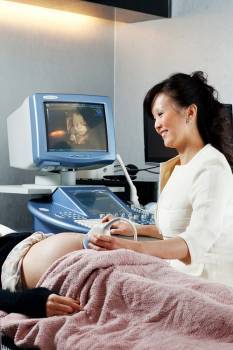Gestational Diabetes
Gestational diabetes mellitus (GDM) is a type of diabetes that occurs only during pregnancy. Like other forms of diabetes, gestational diabetes affects the way your body uses sugar (glucose). Around 4% of pregnant women will have GDM.
 GDM typically occurs in the third trimester of pregnancy, in other words from 28 weeks of pregnancy onwards.
GDM typically occurs in the third trimester of pregnancy, in other words from 28 weeks of pregnancy onwards.
Gestational diabetes usually does not cause noticeable signs or symptoms in the pregnant women. Rarely, gestational diabetes may cause excessive thirst or increased urination. But doctors do not rely on symptoms to diagnose GDM.
The only way to diagnose GDM is through a special blood test called oral glucose tolerance test (OGTT). OGTT at 28 weeks of pregnancy is advised for women at risk of developing GDM. This is the only way doctors can diagnose GDM with certainty.
At every antenatal visit, the pregnant woman’s urine would be tested for glucose. If the urine glucose is very high, the GDM is suspected, and the woman will be advised to undergo OGTT at 28 weeks. Otherwise, all pregnant women at risk of developing GDM would be advised to undergo OGTT at 28 weeks of pregnancy, even if their urine glucose is not high.
The babies of mothers with GDM may be at increased risk of:
• Excess growth. Extra glucose can cause your baby to grow too big while developing in your womb (macrosomia). Very large babies are more likely to get wedged in the birth canal. This may result in the babies sustaining birth injuries or requiring assisted delivery (like forceps and vacuum) or Caesarean delivery.
• Excessive amniotic fluid. There may be formation of excessive amniotic fluid around the unborn child if the gestational diabetes is not well-controlled. This large volume of fluid inside the womb predisposes premature rupture of membranes and the associated risks of infection and premature delivery.
• Low blood sugar (hypoglycemia). Sometimes babies of mothers with gestational diabetes develop low blood sugar (hypoglycemia) shortly after birth. If the baby’s blood sugar is too low, the baby may have fits. Rarely brain damage may result. Close monitoring of baby’s blood glucose levels, regular milk feedings and sometimes an intravenous glucose solution is necessary to ensure the well-being of the baby.
• Respiratory distress syndrome. Babies born to women with gestational diabetes tend to have more breathing problems than do those born to women without the problem, even at term. Babies who have respiratory distress syndrome might need to stay in Neonatal Intensive Care Unit to receive help with their breathing until their lungs become stronger.
• Jaundice. The incidence of jaundice is higher in babies of women with gestational diabetes. Although jaundice can usually be treated with phototherapy; permanent brain damage may result in severe cases.
• Diabetes later in life. Babies of mothers who have gestational diabetes have a higher risk of developing obesity and diabetes later in life. Rarely, untreated gestational diabetes results in a baby's death either before or shortly after birth.
Risk factors for developing gestational diabetes include:
 • Age 35 or older.
• Age 35 or older.
• Overweight. If your pre-pregnancy body mass index (BMI) is 28 or higher.
• Family history of diabetes. If a close family member, such as a parent or sibling, has diabetes, your risk of developing gestational diabetes is higher.
• Personal history of gestational diabetes. If you had gestational diabetes in previous pregnancies, the chance of having it again in subsequent pregnancies is higher too.
• Past history of delivering babies who weighed more than 4kg.
• Past history of unexplained stillbirth.
Women with risk factor(s) for developing gestational diabetes should be tested with OGTT at 28 weeks of pregnancy.
GDM cannot be really prevented, as it is more of a genetic predisposition. But mitigating factors include maintaining a healthy weight and having children at a younger age.
If you are diagnosed with gestational diabetes, you should try to keep your blood sugar levels within normal range at all times. You will be taught to monitor your blood sugar level (home glucose monitoring) using a glucometer. You will need to know how to modify your diet such that it will provide sufficient nourishment for you and your baby while maintaining a control on the blood glucose levels.
Dietary control will be used as first line of management. 90% of women with gestational diabetes can be managed with dietary control alone. For the remaining 10% of patients whose blood sugar cannot be controlled with diet alone, they will need treatment with insulin.
GDM also increases the woman’s personal risk of:
• Pre-eclampsia. Gestational diabetes increases the risk of preeclampsia, a condition characterized by high blood pressure and excess protein in the urine after the 24 weeks of pregnancy. Left untreated, preeclampsia can lead to serious or even life-threatening complications for both mother and baby.
• Urinary tract infections. Women with gestational diabetes experience twice the number of urinary tract infections during pregnancy than other pregnant women experience. This is likely due to excess glucose in the urine. If the infections become severe, premature delivery may occur.
• Future diabetes. If you have gestational diabetes, you're more likely to have it again with a future pregnancy. You're also more likely to develop diabetes, as you get older. However, making healthy lifestyle choices such as eating healthy foods and exercising can help reduce the risk of future diabetes.
The best way to prevent the above complications is to maintain a good blood glucose control.
Fortunately, GDM is usually temporary. The condition will resolve by 6 weeks after delivery. Women who are diagnosed to have GDM are usually advised to undergo another OGTT 6 weeks after delivery to confirm that GDM has resolved.
Expert Author:
Dr Chee Jing Jye
Medical Director, The Obstetrics & Gynaecology Centre, a Singapore Medical Group (SMG) Clinic.
Dr Chee has been looking after obstetrics and gynaecology patients for the past 13 years. She sub- specialises in maternal foetal medicine.
